Every cat lover knows that cats are unique in relation to their breeds. Some of them possess unique personalities while others have distinct physical characteristics.
Choosing the right breed that suits your lifestyle, environment, family, or even your financial situation is quite important to prevent any unwanted issues down the road.
So, if you are thinking of getting a unique striped cat, here are 17 striped cat breeds that you should know.
Table of Contents
1. Bengal Cat
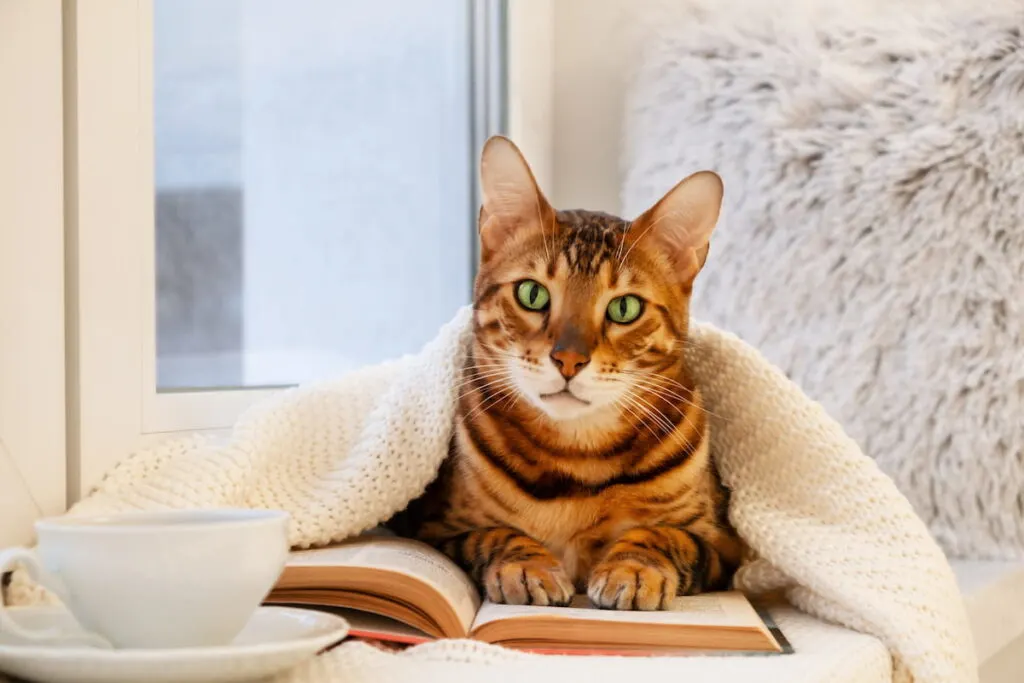
Bengal cats can be considered exotic striped cats.
This is due to the fact that it has both stripes and spots on its body. At a glance, this breed might look like a wild cat because its size is larger than normal domestic cats.
It usually has a beautiful spotted coat that can be orange, brown, golden, charcoal, and rusty colors. Some breeds might have distinctive spots shaped in marble-like patterns with more than one color.
Its muscular body is agile due to its active and wild nature.
Bengal cat is a cross-breed between a domestic cat and an Asian Leopard Cat (Prionailurus bengalensis), making them an exotic pet for any cat lovers.
This breed is highly affectionate, talkative, playful, loves to move around and climb high places.
So, a lot of attention is needed for any cat lover who wants to keep the Bengal cat as a pet.
Also, Bengal cat needs to be fed with nutritious meal or kibbles and grooming must be done at least once a week.
2. Dragon Li
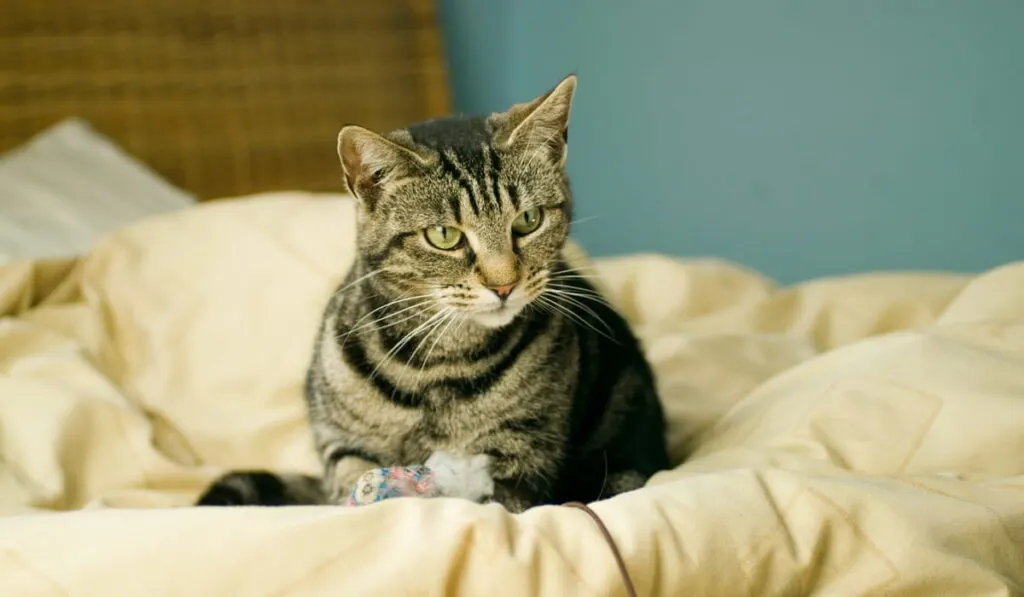
Dragon Li cat, also known as Li Hua Mao (meaning Fox Flower Cat) is one of the earliest breeds of Chinese domestic cats.
This purebred cat is a direct descendant of the Chinese Mountain cat (Felis Bieti) and is believed to be originated as far back as the Xiang Dynasty.
Dragon Li has strong legs and a body with thick and short hair. Its hair coat is commonly brown at the tip and black at the root.
This cat has almond-shaped eyes with different colors of yellow, green, and brown.
Dragon Li is an active cat with a playful and loving personality. A lot of attention and physical space is needed if you ever consider adopting this cat as your pet.
This cat loves to run around, whether indoor or outdoor.
Feeding them a nutritious meal rich in protein is important due to their large appetite and active lifestyle.
It is also advisable to groom this breed at least once a week to keep their hair healthy and beautiful.
3. American Shorthair
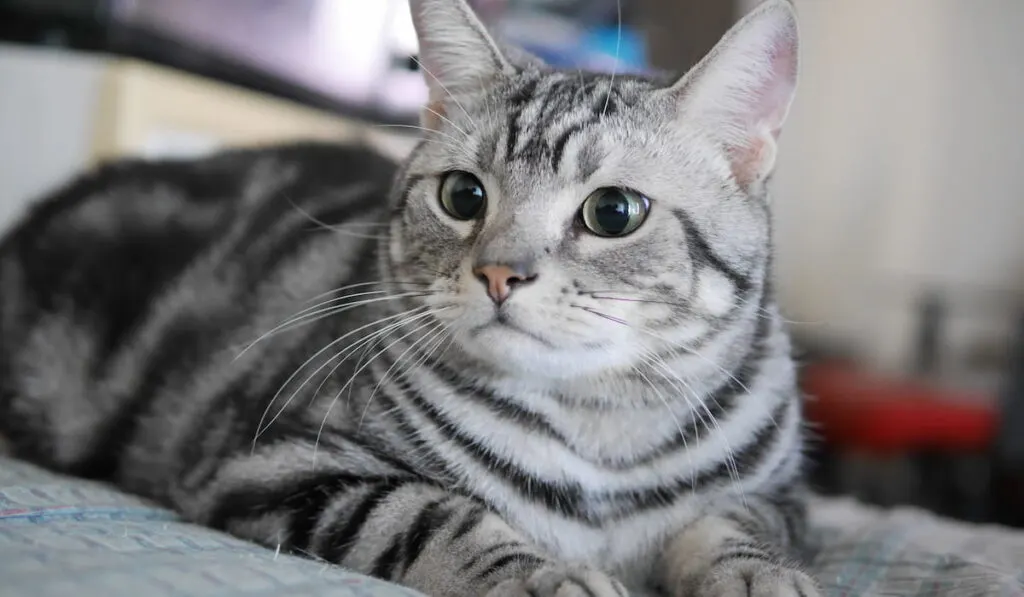
This breed is a descendant of domestic working cats, originated from early domestic cats brought by European sailors and travelers back in the old days.
Because of their strong hunting instinct, they were once used as effective pest controllers in eliminating rodents and mice.
American Shorthair has a medium to large-sized body, a face with full cheeks, and a beautiful thick and dense striped coat with different colors like brown, gray, black, beige, white, orange, ebony, and also red.
This cat has a playful and outgoing personality.
Keeping them as a pet would be a great choice as they mingle easily with other pets and humans.
One to thing remember is that they could easily become overweight if they aren’t active and their diet isn’t being properly maintained.
They are self-sufficient when it comes to grooming because they regularly groom their own hair. So, they are less costly compared to other breeds.
4. Pixie-Bob
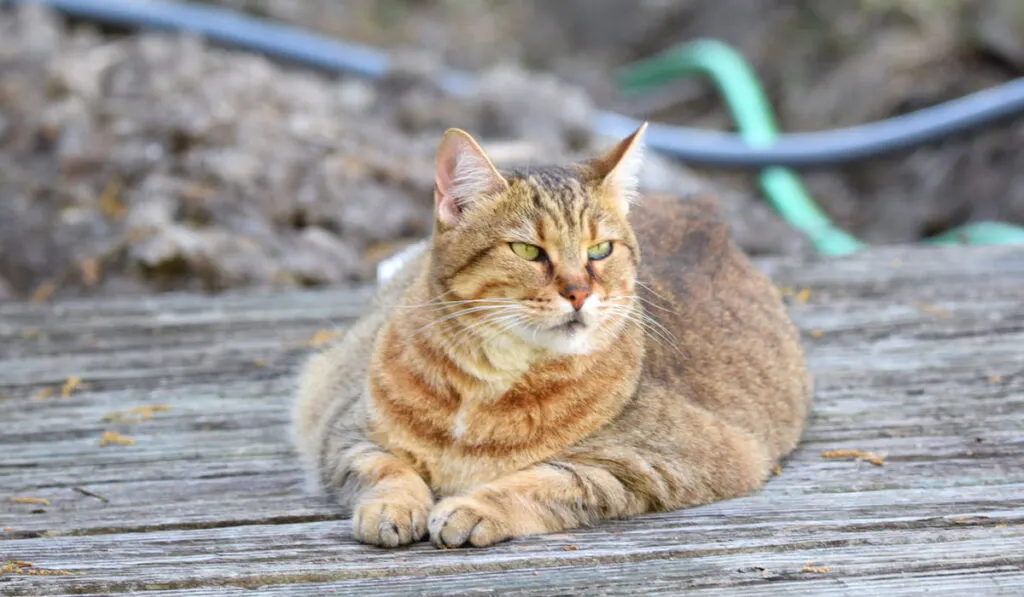
Pixie Bobs are medium to large-sized cats with strong bodies, resembling bobcats.
This breed has thick double coats, either short or long, and a brown stripes (or tabby) pattern. This stripes pattern makes them look like wild cats. Also, their coats are mostly weather-resistant.
Pixie Bob cats are perceived to behave like a dog, highly affectionate, and loyal to their owner.
One distinctive character of this cat is that they have a short tail.
Due to their thick coats, it is advisable to groom them frequently to keep their hair and coats healthy.
Some Pixie Bobs are polydactyl, meaning that they can have extra toes.
This cat doesn’t ‘meow’ as much as other cats, except growling, hissing, and purring. Unlike other cats, Pixie Bobs love water, which could make it easier to give them a bath from time to time.
Their diet is not as strict as other breeds, making it less expensive to feed them regularly.
5. European Shorthair
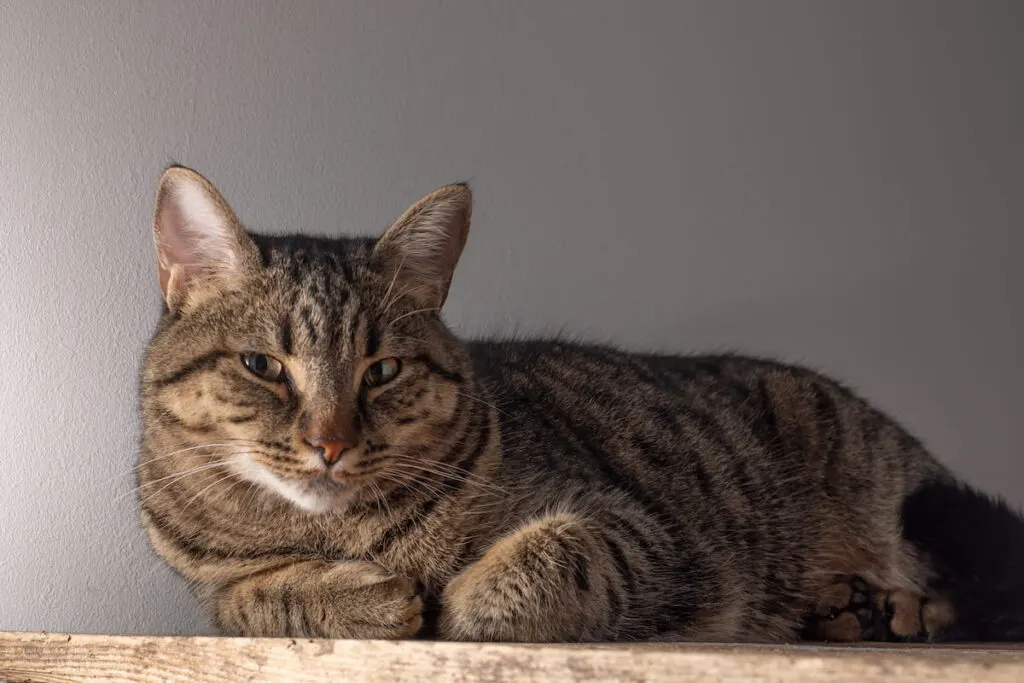
European Shorthairs are also known as the Celtic Shorthairs.
They are medium-sized cats and weigh around 8 to 15 pounds. This breed is one of the oldest European breeds with round faces, small ears, sturdy bodies, short legs, and short thick coats.
They also have beautiful eyes with different colors such as amber, blue, green, or odd-eyed with one blue or amber.
Historically, like American Shorthairs, they were once bred to control rodents’ population.
European Shorthair cat is known for its hunting skills, playfulness, flexible attitudes, and affectionate personality, making them one of the great choices for pets.
This cat also requires minimal grooming but a healthy diet must be maintained to prevent them from getting overweight.
But generally, this breed is healthy and resilient to disease with a life expectancy of 15 to 20 years.
6. Toyger Cat
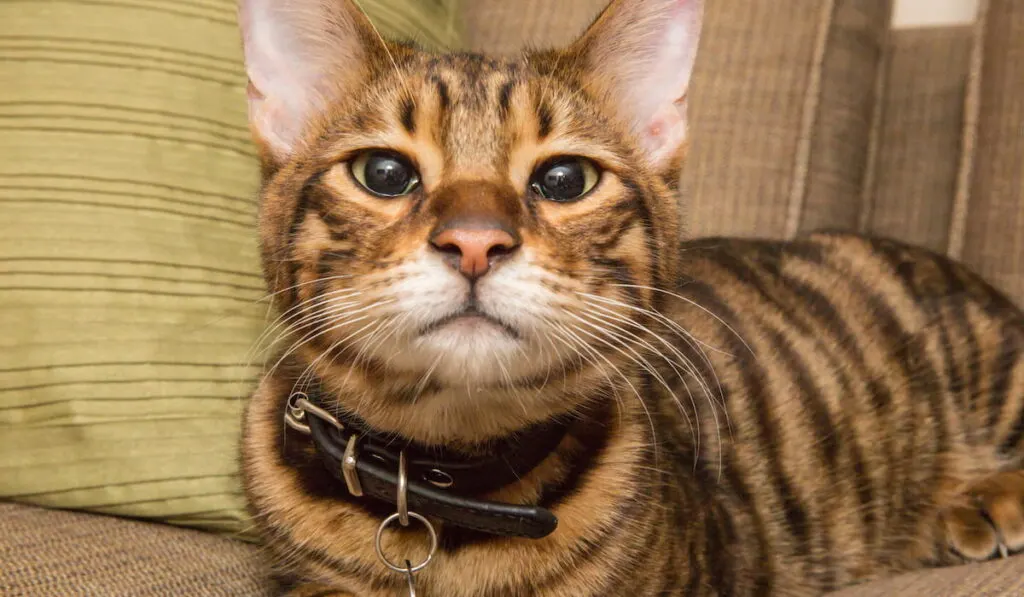
As their name suggests, their appearance is similar to that of a tiger. Toyger cats are medium-sized cats with beautiful bright orange coats and dark vertical stripes on their body.
Their eyes are usually dark brown or hazel in colors. One of their physical traits is circular facial marks which can’t be found on other breeds.
This breed is a mix between Bengal cats and striped domestic shorthairs. Although resembling a small tiger, these domestic cats are warm, playful, and affectionate in nature.
Keeping them active with toys to play with or human interaction is also important.
Other than trimming their nails, Toyger cats need to be groomed at least once a week to keep their hair healthy.
Also, Toygers are generally healthy but regular visits to the vet must be done to prevent any unnoticed health conditions.
7. American Bobtail
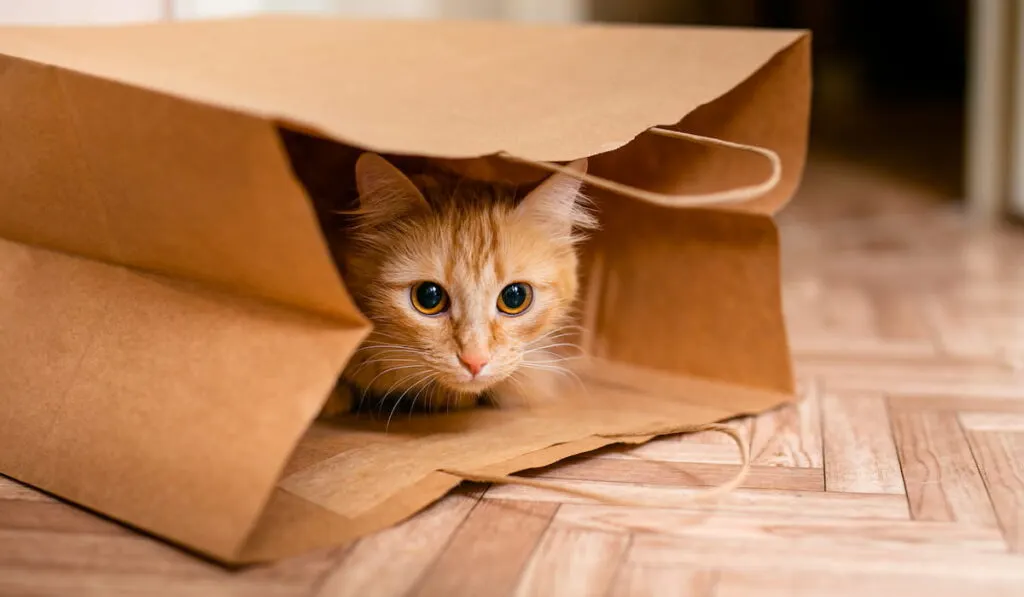
American Bobtails are medium to large-sized cats with a distinctive short (bobbed) tail.
Their coat varies from medium to long, with different colors or patterns. Some of them might also have shaggy-like hair, giving them the appearance of wild cats.
This breed is playful, energetic, and friendly, making them a great companion to be adopted as a pet. Also, due to their dog-like nature, they always love human interaction and companion.
It is advisable to groom them at least once a week to remove loose hair from their undercoat.
8. Domestic Shorthair
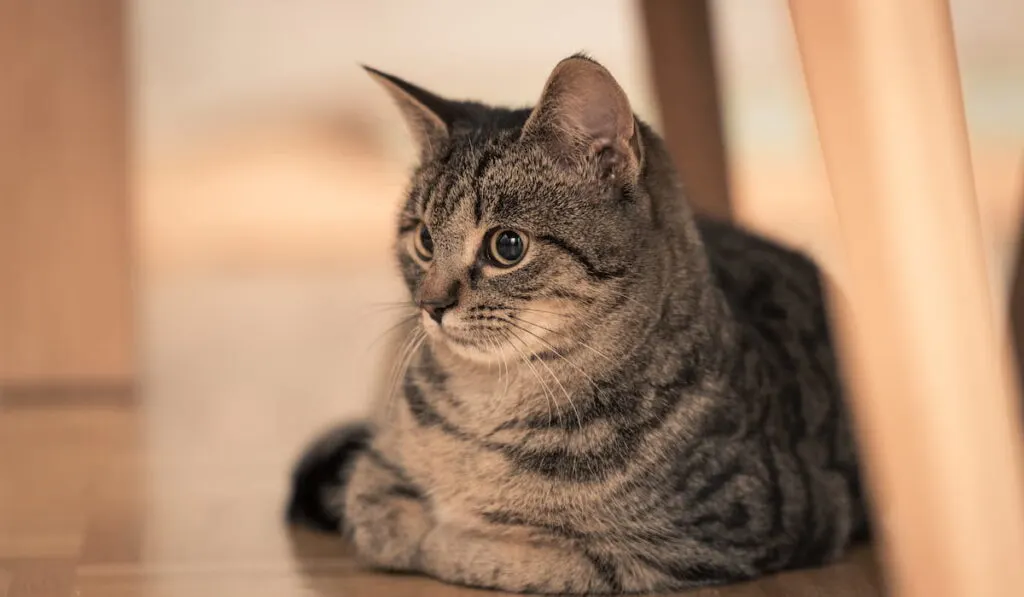
Domestic Shorthairs are totally different from American and British Shorthairs. This breed is larger than American Shorthairs but smaller than British Shorthairs.
They originated in Egypt around 2000 B.C. These domestic cats come in different sizes and colors (tricolor, striped, and tabby).
Their eyes also vary in colors from blue, green, brown, hazel, even with two different colors (heterochromia).
Domestic Shorthair cats have round heads and sturdy bodies. Generally, their life spans can reach up to 14 years or more. Like other shorthairs breed, they are playful and good at hunting.
They would make a great house cat because of their low maintenance and they can groom themselves well.
9. Kurilian Bobtail
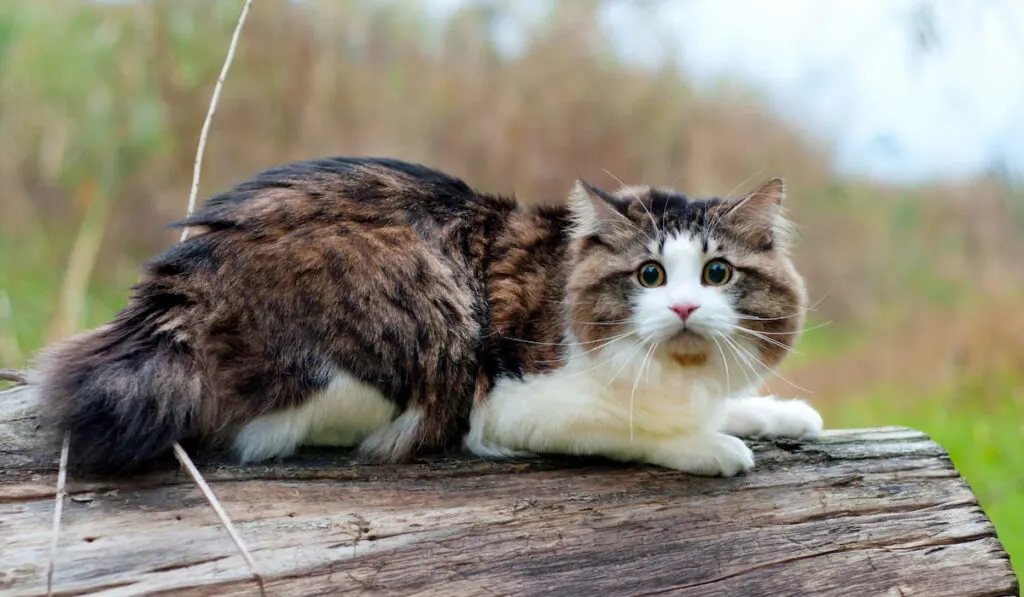
This natural breed of cats originated from Sakhalin Island, Russia, and Kuril archipelagos between Japan and Siberia.
They are medium to large-sized cats with naturally bobbed and short tails. Kurilian Bobtails also possess a strong body with different colors and long hind legs, making them quite a jumper.
Their thick coat varies from short to long, with different markings and tabby patterns.
This breed is sociable and loves to play. They are a good cat to have around children due to their playful nature.
Although their coat is thick, grooming could be done just once a week because their hair is soft and not easily tangled.
10. Serengeti Cat
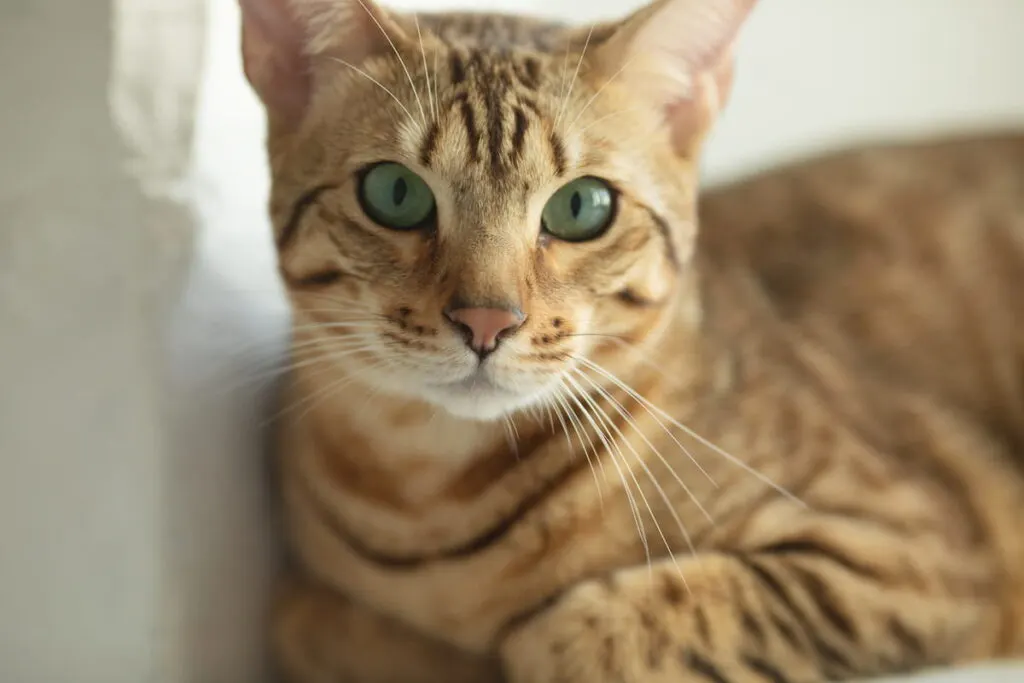
Serengeti cats are medium-sized cats with distinctive long legs.
They are a mixed breed between Bengal and Oriental Shorthair cats, created by a conservation biologist and owner of California’s Kingsmark Cattery, Karen Sausman.
This breed is typically golden or gray in color, with unique markings stripes, or spots, resembling Serval cats. Serengeti cats are athletic, active, and love attention.
They also love to run around and jump in high places. But most importantly, they are affectionate and loyal to their owners.
When keeping this cat indoors, make sure to give them toys to play with so that they don’t feel bored.
This breed is a low maintenance cat without strict diet or meals requirement. They also don’t need much grooming because their silky coat is short and tight.
They are mostly self-sufficient as they will groom their own hair.
11. Exotic Shorthair
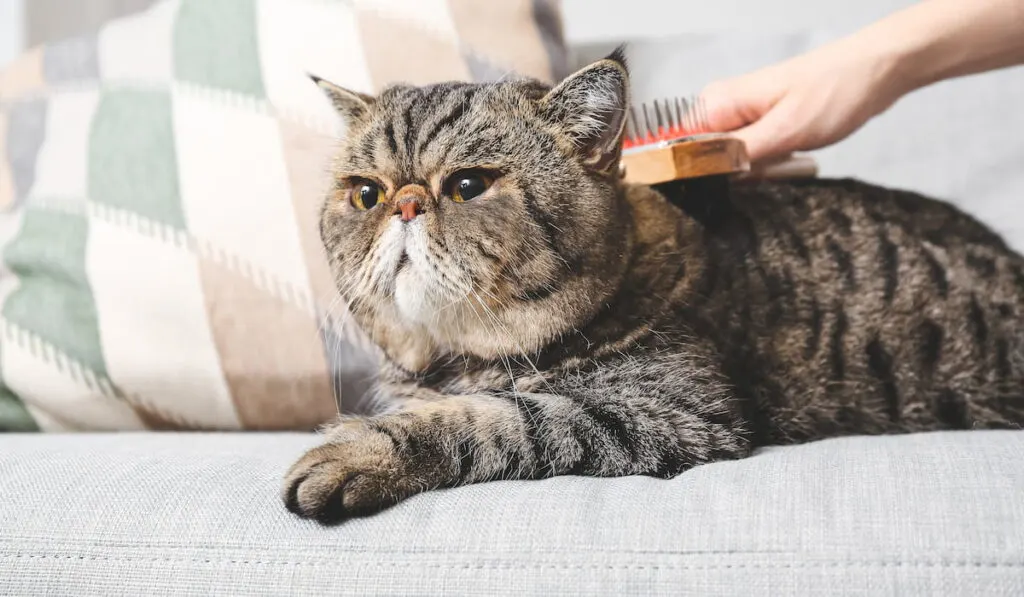
Exotic Shorthair cats are a mix between American Shorthairs and Persian breeds, giving them the cute and chubby look of Persian cats.
These medium to large-sized exotic cats are brachychepalic, which means that their face is generally round, short, and broad with flattened muscles.
This breed has a thick long coat with many different colors, stripes, and patterns.
They have a calm and laid-back personality, making them a great companion.
Sometimes, they can be playful but due to their lower energy levels, owners of this cat need to watch their pet’s diet and meals to prevent any weight issues.
Unlike Persian cats, their hair doesn’t tangle easily. So, they need less grooming (at least once a week to remove loose hair).
12. Arabian Mau
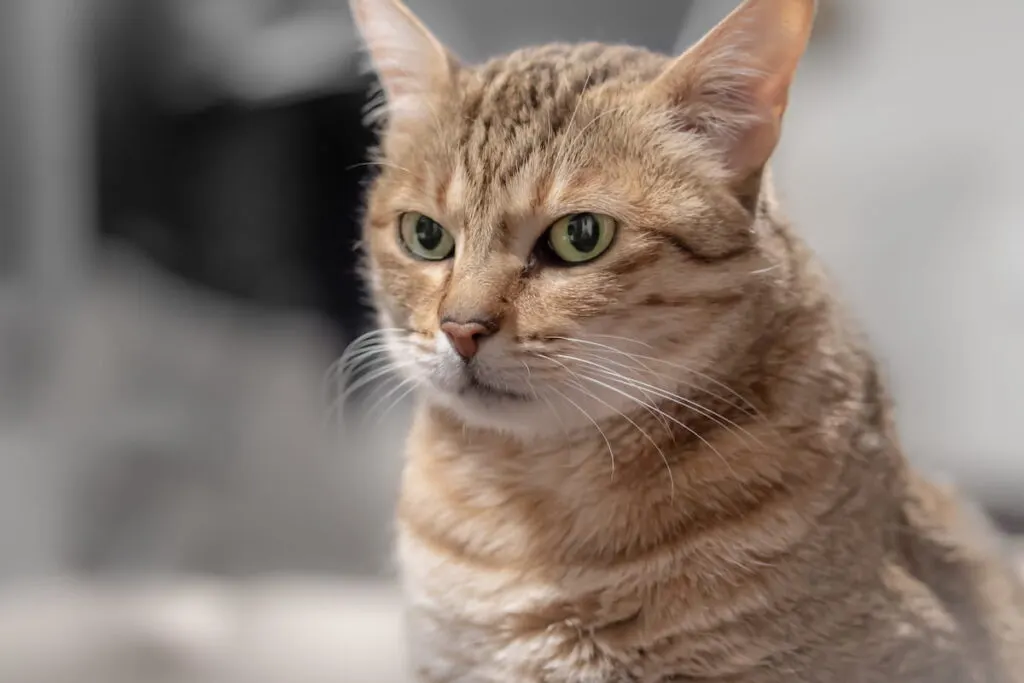
This natural cat breed is native to the Arabian Peninsula like Saudi Arabia, Kuwait, and Oman.
Arabian Maus are medium to large-sized cats with short hair that comes in different colors and tabby-like markings.
One of the special traits about this cat is they are resistant to hot temperature due to their place of origin.
Because of their short and silky hair, there is less need to groom them frequently. They will groom themselves from time to time. Also, this cat is naturally energetic and active.
If you’re thinking of leaving them alone, giving them enough room to run around or toys to play with would be the best way to keep them happy.
They are generally healthy and resilient to diseases but regular visits to the vet would also beneficial to maintain their health.
13. Sokoke Cat
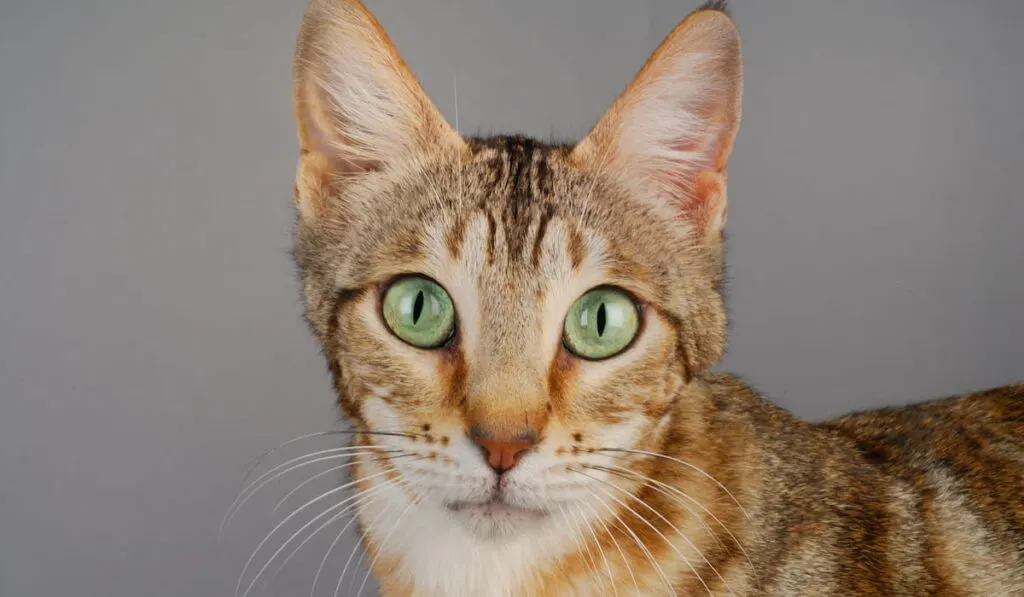
Sokoke cats (also known as Khadzonzos which means ‘bark’) originated from the Arabuko Sokoke forest in Kenya.
This rare breed of the domestic cat is a medium-sized cat with an athletic and lean figure. They were first discovered by Jeni Slater, a wildlife artist and horse breeder in 1987.
This breed has some distinctive physical traits like long ears, tapered tails, and wedge-shaped faces.
But their most unique trait is their tip-toe gait, which is completely different from any other domestic breeds. Sokoke cats are active, playful, and affectionate.
Unlike other cats, they love water and are not afraid to play around in any wet places. They also don’t need much grooming because their coat is thin and short.
14. Norwegian Forest Cat
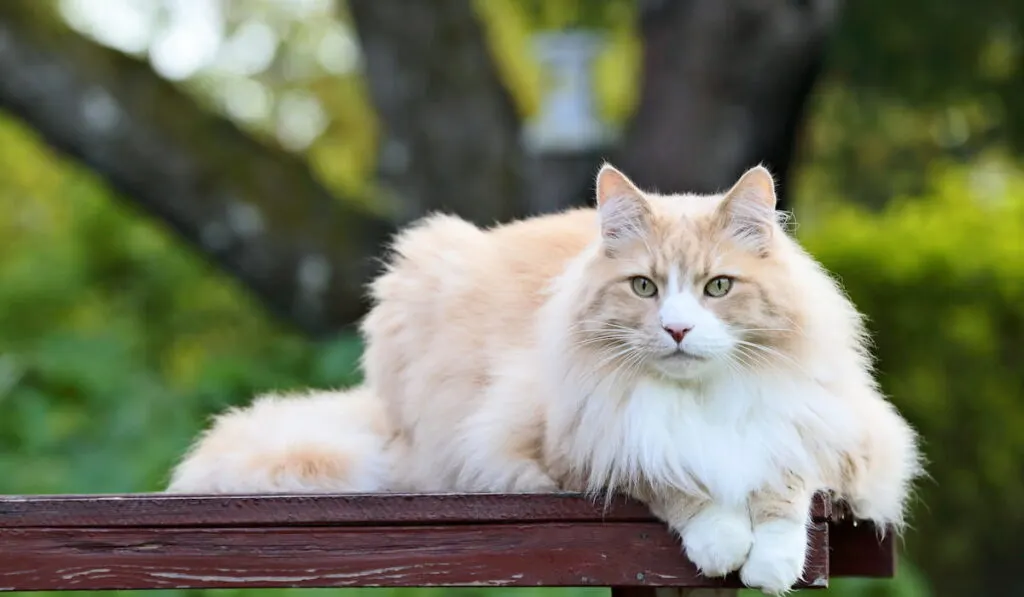
At a glance, Norwegian Forest cats might look similar to Maine Coon cats.
But they are two totally different breeds. Norwegian Forest cats (also know as Skogkatt) are generally large cats and native to Northern Europe.
They have a muscular body with thick and dense beautiful coats, which contribute to their large physical appearance.
Their coat varies in color. Some of them also have white patches on their coat. Norwegian Forest cats are territorial in nature. So, they need a lot of personal space.
But they are also loving and playful with others, especially with people they are familiar with.
One thing to keep in mind is that due to their thick hair, this cat needs to be groomed at least once a day to prevent tangles or knots within their coat.
They are self-sufficient in maintaining their own diet and health. So, one less thing to worry about when keeping this cat as a pet.
15. American Curl
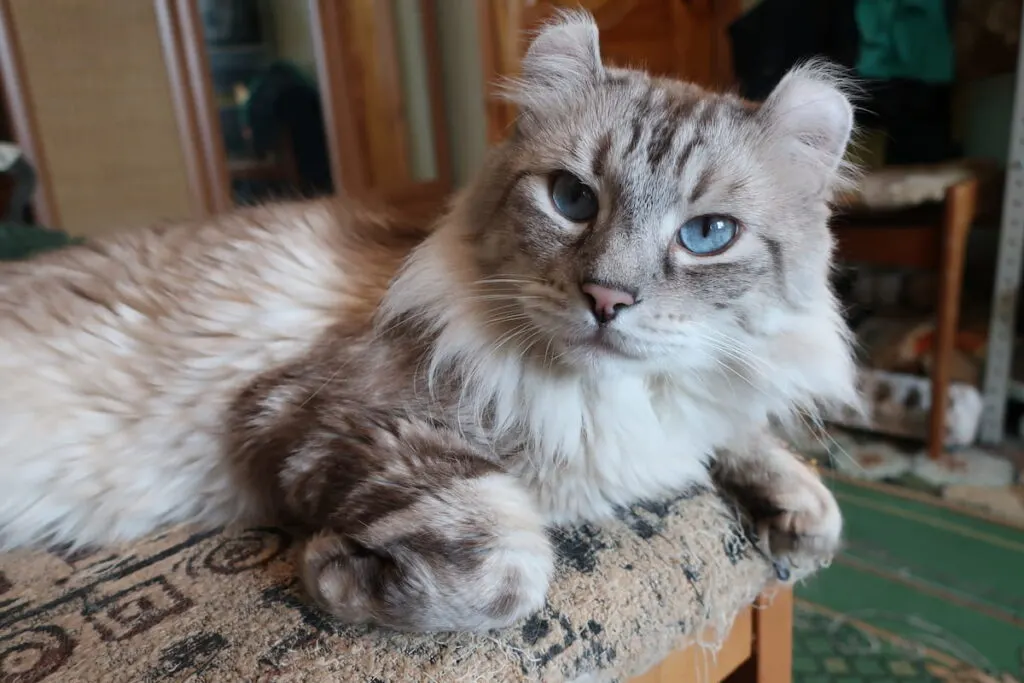
American Curls originated as a spontaneous genetic mutation in the domestic cat population back in 1981.
This breed is a small to medium-sized cat. Their name derived from their unique large ears that curl backwards.
This breed has eyes with different colors ranging from blue, green, copper, orange, yellow, hazel, and gold. They also possess different hair colors.
American Curl is a lively and cheerful cat that loves human interaction and attention, especially from children.
Their fondness and sociability make them a great choice for any cat lovers who love affectionate indoor cats. Also, they are generally healthy and not as costly as other breeds.
It is recommended to groom their hair and trim their nails once a week to keep them healthy.
16. Manx Cat
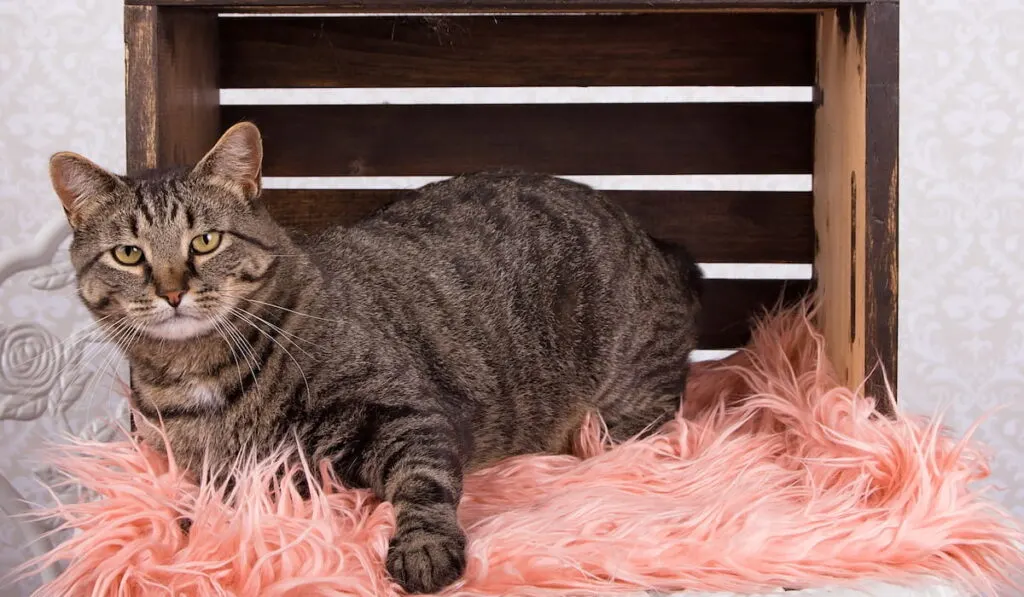
Manx Cat originated from the Isle of Man, located in the Irish Sea.
It is known as one of the oldest cat breeds. This breed is pretty unique and distinguishable because of its really short stump of tail compared to other breeds.
Also, some of these cats are considered tailless. Because of its tail, The Manx are also called Stumpies or Rumpies. Their body and head are generally round, with thick short hair and coats.
Their front legs are quite short, making their hind end slightly higher, which can be easily noticed when they stand. Most Manx are medium in size but some can grow larger due to their dense bone structure.
Keeping Manx cat as a pet comes with strict meal preparation because they prone to become overweight.
Grooming should be done frequently due to its hair that is quite thick. Manx have a loving and affectionate personality, making them one of the most loyal and lovable pets to have around.
17. American Wirehair
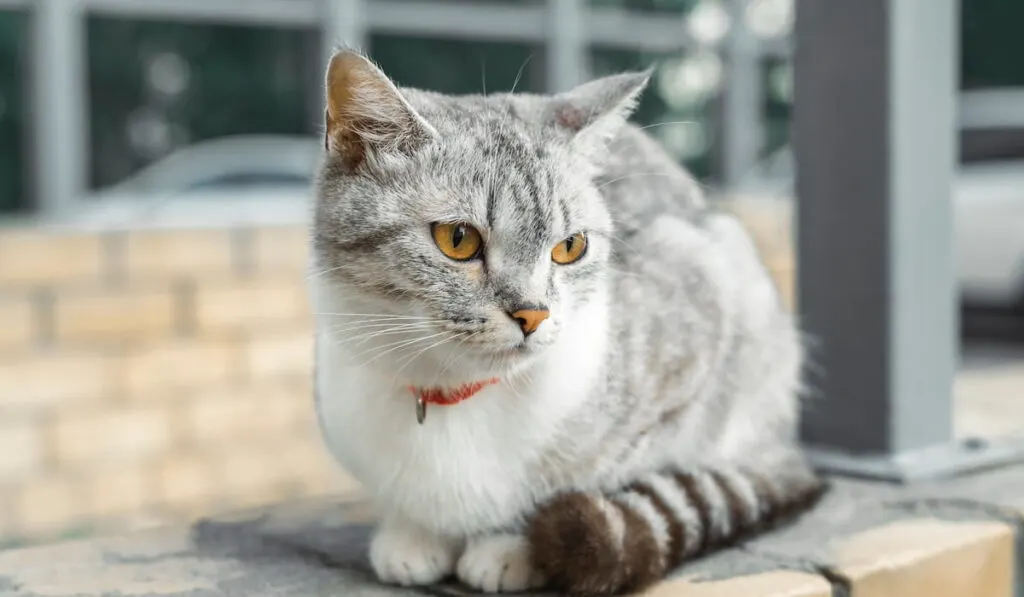
This breed is one of the original American breeds.
In 1966, a litter of upstate New York farm cats experienced natural mutations and later were cross-bred with American Shorthairs, giving birth to this breed.
Like their name, American Wirehair cats have thick and coarse hair that comes in different colors and patterns.
American Wirehair is a medium-sized cat with a round and muscular body.
This cat is affectionate, easy to get along with, and laid-back in nature, which makes it a great choice to be adopted as a pet.
They are generally healthy without much strict diet to watch for and they don’t need much grooming.
Frequent grooming would destroy their coarse hair except during the spring when their hair sheds.
Final Thoughts
Above all, each breed posses its own unique personality, habits, and grooming routine.
Once you know which is which, adopting them will be much easier.
What is important is that you find the right feline that suits your needs without affecting its well-being.
Plus, a happy cat contributes to a happy life!
Citations
Bengal Cat
- https://www.purina.co.uk/find-a-pet/cat-breeds/bengal
- http://www.vetstreet.com/cats/bengal#overview
- https://pethelpful.com/cats/The-Joys-and-Hazards-of-Living-with-a-Bengal-Cat
Dragon Li
- https://petonbed.com/chinese-li-hua/
- https://www.prettylitter.com/blog/5-facts-about-chinese-li-hua-cats
- https://allaboutcats.com/cat-breeds/dragon-li
American Shorthair
- https://trupanion.com/breeds/cat/american-shorthair
- https://www.dailypaws.com/cats-kittens/cat-breeds/american-shorthair
- https://www.petfinder.com/cat-breeds/american-shorthair/
Pixie Bob
- https://cattime.com/cat-breeds/pixie-bob#/slide/1
- https://www.purina.co.uk/find-a-pet/cat-breeds/pixiebob
- https://www.dailypaws.com/cats-kittens/cat-breeds/pixie-bob
European Shorthair
- https://cattime.com/cat-breeds/european-shorthair#/slide/1
- https://www.dailypaws.com/cats-kittens/cat-breeds/european-shorthair
- https://www.viovet.co.uk/breed_information/1-37/European-Shorthair
Toyger Cat
- https://www.petfinder.com/cat-breeds/toyger/
- http://www.vetstreet.com/cats/toyger
- https://www.holistapet.com/cat-breeds/toyger/
American Bobtail
- https://www.pawculture.com/breed-basics/cat-breeds/all-about-american-bobtails/
- https://www.petfinder.com/cat-breeds/american-bobtail/
- https://cfa.org/american-bobtail/
Domestic Shorthair
- https://www.hillspet.com/cat-care/cat-breeds/domestic-shorthair
- https://www.aspcapetinsurance.com/resources/domestic-shorthair-cat-facts/
- https://www.argospetinsurance.co.uk/we-talk-pet/breed-review-domestic-shorthair-cat/
Kurilian Bobtail
- https://www.pawculture.com/breed-basics/cat-breeds/kurilian-bobtail-cat-breed/
- http://www.vetstreet.com/cats/kurilian-bobtail#overview
- https://www.petguide.com/breeds/cat/kurilian-bobtail/
Exotic Shorthair
- http://www.vetstreet.com/cats/exotic-shorthair#0_sb32r7w2
- https://www.petfinder.com/cat-breeds/exotic-shorthair/
- https://www.thesprucepets.com/exotic-shorthair-cat-breed-profile-4774331
- Arabian Mau
- https://www.viovet.co.uk/breed_information/1-9/Arabian-Mau
- https://www.thegreatcat.org/cat-breeds-and-species/arabian-mau/
- https://www.petguide.com/breeds/cat/arabian-mau/
Serengeti Cat
- https://www.petguide.com/breeds/cat/serengeti/
- https://cattime.com/cat-breeds/serengeti#/slide/1
- https://www.tica.org/breeds/browse-all-breeds?view=article&id=892:serengeti-breed&catid=79
Sokoke Cat
- https://www.prettylitter.com/blog/sokoke-hybrid-cat-basics
- https://www.animalwised.com/cat-breeds/sokoke.html
- https://www.gccfcats.org/Cat-Breeds/Sokoke
Norwegian Forest Cat
- https://www.hillspet.com.my/cat-care/cat-breeds/norwegian-forest-cat
- https://www.petinsurance.com/healthzone/pet-breeds/cat-breeds/norwegian-forest/
- https://cattime.com/cat-breeds/norwegian-forest-cats#/slide/1
American Curl
- http://www.vetstreet.com/cats/american-curl#grooming
- https://www.thegreatcat.org/cat-breeds-and-species/american-curl-cat/
- https://www.pawculture.com/breed-basics/cat-breeds/american-curl-cat-breed/
Manx Cat
- https://www.petfinder.com/cat-breeds/manx/#historySection_jumpTarget
- https://www.hillspet.com.my/cat-care/cat-breeds/manx
- https://cfa.org/manx/
American Wirehair
